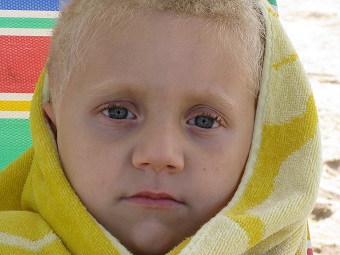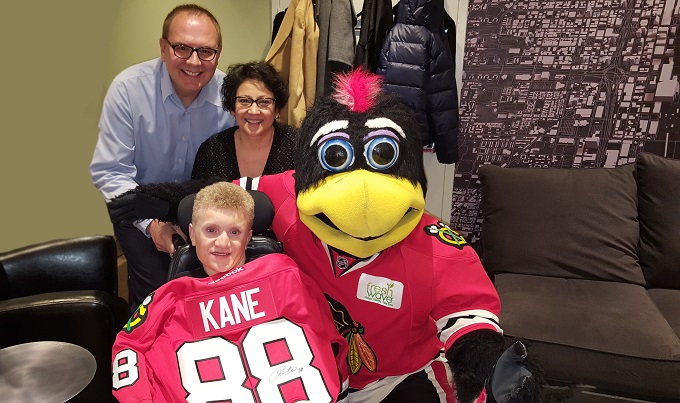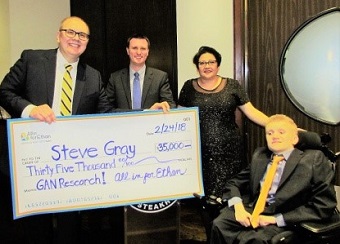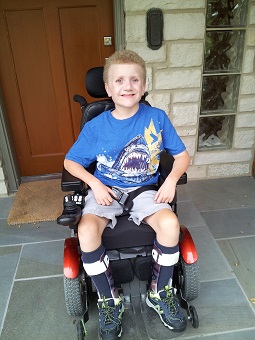Tkalec Family’s $35,000 gift supports GAN gene therapy research

In 2005, Ethan was still able to stand at 2 years old.
By Sharon Reynolds
Gelse and John Tkalec were thrilled to become new parents after adopting their son, Ethan, at three days of age. He was a good-natured baby and brought much joy to their lives.
When Ethan was nearly 2 ½ years old, the Tkalecs became concerned after noticing an awkwardness to his agility. He’d often trip over small things and fall to the ground, and he crawled up stairs on his hands and knees. He couldn’t run alongside and keep up with other toddlers his age. Doctors said his symptoms could be one of a hundred different disorders and advised a “wait-and-see” approach to his care.
Ethan’s mobility issues persisted and in July 2008, pediatric specialists finally diagnosed the then 6-year-old boy with a neurodegenerative disorder, Giant Axonal Neuropathy (GAN), which causes nerves to die and muscles to stop working. GAN is an inherited disorder caused by mutations in a single GAN gene that has no cure and no viable treatment. There are fewer than 100 confirmed cases of GAN in the world and because it’s so rare, it is difficult for patients to get properly diagnosed or to meet other people with the disease.

Five-year-old Ethan relaxed on the beach in South Haven, Michigan.
Pale dry skin and brittle, kinky, curly hair is usually a commonality shared among children with GAN, and their hair is usually different from their siblings, which can be straight. Children with the disorder begin experiencing problems walking in early childhood and may later lose sensation, coordination, strength, and reflexes in their limbs. Hearing and visual problems typically occur, and the children eventually lose all control of their bodies and become quadriplegics. Most of them will die in their teens or 20s.
The Tkalecs were devastated.
“We felt like a freight train ran us over,” said Gelse. “For a while we wanted to hide, take shelter in our home, and not deal with the outside world. Because GAN was so rare, nobody could tell us about the disease and its progression. But one thing we knew for certain – GAN was a terminal illness, and our son was going to die.”
Today Ethan is 15 years old, and GAN has taken a toll on his body. He can no longer walk, eats through a feeding tube, and is losing the use of his hands. He has paralyzed vocal chords, glaucoma, acid reflux, frequent urinary tract infections, scoliosis, and limited lung capacity.
As his primary caregiver and nurse, Gelse describes the heartache and immense sense of powerlessness that she and her family have faced throughout Ethan’s lifetime. Her son, she says, remains a shining light. He attends Riverside-Brookfield High School in a Chicago suburb with a one-to-one registered nurse at his side throughout the school day. His favorite class is choir, along with painting and drawing, acting, and adaptive physical education. Ethan is surrounded by family, friends, and loved ones and is a member of Best Buddies, a support program for students with intellectual and developmental disabilities. He cherishes his relationship with his best buddy, Jake.
"GAN is a progressive disease, and we don’t know when the next progression is going to hit,” Gelse said. “This disease has taken so much away from Ethan. To keep him as healthy as possible, we do different types of therapies on a daily basis. He is a magnificent person.
He’s positive every day despite all the challenges he faces. Strangers have come to me and told me that Ethan inspired them to live their life in a different way. The hardest thing is watching my son die a little every day and seeing this bright, shining star get dimmer.”
Families Uniting for Cures
One year into Ethan’s disease, the Tkalecs discovered hope on the internet. Hannah’s Hope Fund was a new nonprofit organization that was raising funds to find new treatments and a cure of GAN. Hannah Sames had been diagnosed with GAN just a few months before Ethan, and her parents, Lori and Matt Sames, decided to do whatever it took to save their daughter’s life. At that time, they found only one scientist in the world actively studying GAN and immediately began raising money for GAN research. They organized and funded a scientific symposium to bring physicians, researchers, and families together to become a strong force in the fight against GAN.
Through their involvement in Hannah’s Hope Fund, the Tkalecs have attended scientific conferences and have met people from around the world. They wanted to do more for children affected by GAN, so they founded All In For Ethan, Inc., a 501(c)3 nonprofit organization with a mission to enhance the quality of life for kids with GAN and to fund research. All In For Ethan, Inc., is run by volunteers who hold their annual "Rare But Not Forgotten..." fundraiser in Oak Brook, Illinois. Generous donations make an immediate impact on the lives of GAN patients while they are still able to do the things they enjoy. They have funded research and provided medical equipment, therapy sessions, and airfare to the National Institutes of Health (NIH), as well as provided room make overs, birthday parties, concert and movie tickets, Barbie dolls, iPads, ride-on toys, driving lessons, and school clothing.

Ethan appeared on Windy City Live in 2017 and was thrilled with a surprise visit from the Chicago Blackhawks mascot Tommy Hawk and a jersey and video message from star player, Patrick Kane.
The Tkalecs keep in touch with other families through a private GAN Facebook page, which has become a forum to discuss the health of their children and the latest GAN treatments and research. Here, they are able to connect with other GAN parents from around the world who intimately understand the struggles to live with this destructive disease.
The Forever Fix of Gene Therapy
The Tkalecs attended their first GAN scientific conference at the National Institutes of Health in Bethesda, Maryland and met Dr. Steven Gray, who at the time was an industry-leading gene therapy scientist from the University of North Carolina at Chapel Hill. Dr. Gray was working to develop human clinical trials to test a gene therapy approach for GAN. Gene therapy stops a disease permanently by replacing faulty genes with healthy artificial genes to fix genetic problems at the source.
Parent activism through Hannah’s Hope Fund has driven a number of scientific breakthroughs. On May 27, 2015, Dr. Gray’s team of scientists made history by developing GAN gene therapy that was launched by the NIH – the first ever Phase I Clinical Trial in humans to determine the safety of gene therapy for GAN. To date, 10 children ranging from 6-14 years old have been enrolled in the clinical trial and received the treatment. This road to an investigational new drug for GAN was funded 100 percent from Hannah’s Hope Fund up to the Phase 1 trial.
In December 2017, Dr. Gray joined UT Southwestern Medical Center as an Associate Professor in the Departments of Pediatrics, Molecular Biology, and Neurology & Neurotherapeutics, where he continues to develop gene therapy clinical trials to treat several rare neurological diseases. In appreciation of Dr. Gray’s dedication to helping children like Ethan, All In For Ethan made a generous $35,000 gift to support his GAN research.

The Tkalec family presents a gift to Dr. Steven Gray after their annual "Rare But Not Forgotten..." fundraiser.
Dr. Gray is grateful for this support, as well as his relationships with the Tkalec family.
“I met Ethan when he was about 6 years old, and his personality has stayed the same,” said Dr. Gray. “Even though life dealt him a cruel hand, every time I see him he’s cracking jokes and trying to make everyone around him feel better. He’s already spread more joy and affected more people than most people do in their entire lifetimes. I’ve learned a lot from Ethan. In spite of his increasingly frail body, he is an example of what strength and courage really are.”
Dr. Gray says philanthropic gifts have been vital for continuing his GAN research.
“First of all, gifts like this come with an emotional connection to the donor, and everyone in the lab feels a strong responsibility to be good stewards of the funds,” he said. “The pace of scientific discovery is moving quickly and many doors are opening to developing cutting-edge treatments. However, traditional, public funding grant cycles often make us sit on good ideas while we wait months and months for reviews and award decisions. Philanthropic gifts allow us to pursue new scientific leads more quickly and to take more calculated risks by testing promising ‘out-of-the-box’ ideas. Finally, most people would be surprised to know the amount of time researchers spend writing grant proposals. Philanthropic gifts allow us to spend more time doing research.”
In the U.S., any disease that affects fewer than 200,000 people is considered rare. GAN is one of nearly 7,000 rare diseases that cause great suffering and hold little hope for a cure. Although each disorder alone affects a small number of people, together rare diseases impact nearly 30 million Americans, among whom 2/3 are children.

Ethan is shown at age 14, enjoying a summer day at home.
The Tkalecs hope GAN becomes one of many diseases that will be eradicated through gene therapy.
"We must continue to fund research because, without it, there are no advancements, no treatments and no hope for a cure,” said Gelse. “Dr. Gray has been a trailblazer. He has a very unique and special ability to speak to people in a way that they will understand complex ideas. Through the years we often sent blood and skin samples off to Dr. Gray to grow cells, and Ethan’s participation in Dr. Gray’s research has helped move science to where it is today to stop or slow the progression of the disease. Ethan has shared his story at our fundraisers and we’ve secured grants for GAN research. We’ve met so many wonderful, generous people along Ethan’s journey. He teaches us all about the power of love in the most profound way.”